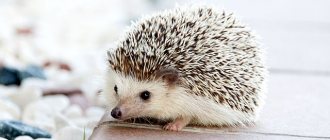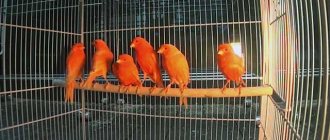Where a pet hedgehog can be purchased: pros and cons of places
The first thing that comes to mind is to pick up a hedgehog somewhere near your summer cottage. Taking the form of a ball is a method of protection from predators, but not from people. The problem is that the animal may not be eager to get to know each other, much less move to a new place of residence. At best, the new hedgehog owner will get away with bites.
IMPORTANT: There is a possibility of contracting parasites and infections from a wild hedgehog - for example, rabies, leptospirosis, lichen, salmonellosis. People and animals can get hurt.
Although if an animal is in trouble and needs shelter, of course, it needs to be sheltered. In this case, you should definitely schedule a trip to the veterinarian. As is the case if a hedgehog is purchased at a poultry market , no one can guarantee that it is healthy.
Often a domestic hedgehog previously lived somewhere in a clearing
Not everyone knows that a pet hedgehog can be purchased from a breeder , just like a puppy or kitten. There are few hedgehog breeders, but finding them on the Internet is quite possible. Such people will be able to provide a guarantee of good animal health and instructions for their maintenance.
Another good option is to purchase hedgehogs from friends who have kept them for a long time. An interesting fact is that hedgehogs are domesticated more quickly than other representatives of the wild . The very first generation, born in captivity, is not at all afraid of humans.
Hedgehogs: keeping in captivity
Most of us are accustomed to close proximity to feathered and four-legged friends. People willingly share shelter with parrots and canaries, cats and dogs, ferrets and decorative rodents.
flickr/Adam Foster
There is also a place next to humans for hedgehogs - prickly little and agile forest inhabitants who, with proper care, care and affection, can become wonderful pets. But first things first, and speaking about how to keep a hedgehog at home, first of all, you should find out where hedgehogs come from in the homes of modern animal lovers.
flickr/richard.heeks
Question of acquisition
Catching a hedgehog in a forest or park is not a difficult task. These funny animals fall into the hands of people thanks to their instinctive defensive strategy - not to run away, but to curl up in a ball and expose their needles. This can scare away a forest predator, but not a person... However, is it worth keeping a hedgehog caught in this way at home?
A healthy animal, caught in the warm season near a forest belt or in the forest itself, does not need human care. Moreover, attempts to forcibly keep a wild hedgehog in your home are fraught not only with wounds from bites, but also with possible infections and parasites transmitted from hedgehogs to people and other domestic animals. However, if the found animal is injured or weakened, you can give it shelter by first showing the hedgehog to a competent veterinarian who can give a general assessment of the animal’s condition, take the necessary tests and prescribe medications.
flickr/Saparevo
Another, less extreme way to acquire a hedgehog is to purchase from a breeder. Nowadays, in large cities of Russia there are entire societies of hedgehog lovers. By purchasing a hedgehog from domesticated parents, the buyer can obtain a guarantee from the seller about the good health of the animal, its positive heredity and human orientation. Hedgehogs, unlike most other wild animals, adapt quite easily to life in captivity and quickly get used to people. Therefore, already the first generation of hedgehogs born from domesticated parents will know and trust the person.
You should absolutely not be fooled by cheap offers from sellers at Poultry Markets. Hedgehogs purchased there often turn out to be terminally ill and potentially dangerous to people and other pets.
flickr/petnobis
The issue of maintenance and feeding
So, the hedgehog is home. What will he need first? A refuge, of course. It is not recommended to let the new tenant freely explore the apartment. A hedgehog can get entangled in wires, climb into places where it cannot get out, injure itself, or damage valuables. Therefore, it is best to put the hedgehog in a cage, preferably a metal or wooden one with a retractable tray. The option of an aquarium can only be temporary, since the microclimate behind solid glass is detrimental to hedgehogs.
It is best to use regular disposable diapers for people or animals as bedding. They absorb well and are convenient for collecting pet waste. Should not be used if the hedgehog really likes to dig. You can use a filler in the form of compressed paper (paper flakes), it also absorbs well and absorbs unpleasant odors. The filler layer should be several centimeters. There should also be plastic bowls with food and pneumatic drinkers. Hedgehogs do not feed on mushrooms and apples, but on meat and insects. Hedgehogs are carnivores. Therefore, the bulk of their diet should be raw, chopped meat.
flickr/simple tess
In nature, hedgehogs also readily eat snails, caterpillars, all kinds of beetles and earthworms, so after a walk in the forest it is quite possible to pamper your pet with its natural food. A good replacement for it can be, for example, bloodworms. Some people are ready to feed their pets with little mice, although there is no great need for this, since at home hedgehogs get everything they need from insects, meat, and boiled liver. By getting a pet hedgehog, its owner can simultaneously acquire useful contacts and organize the process of supplying crickets and cockroaches for his pet.
flickr/latarnia_morska
However, a hedgehog won’t refuse a carrot or an apple either, and rumors about hedgehogs’ passionate love for milk are by no means exaggerated, but it is dangerous for them! They do not digest lactose. It is advisable to clean the cage and feeding area daily to avoid dirt and unpleasant odors.
flickr/Susanna — Mielen maisemia
Anyone who has decided to keep a hedgehog in their home should know a few facts about the life of these cute, but not the easiest animals to keep at home:
- Hedgehogs are predators, as mentioned above. Proper nutrition is the key to health and long life.
- Hedgehogs are loners. If you have more than one hedgehog at home, they should be placed in separate cages. The exception is young animals and opposite-sex pairs during the breeding season.
- Hedgehogs reproduce in the spring, soon after emerging from hibernation, but in captivity it is not so easy to get offspring from them. To do this, you need to wisely choose the appropriate period and bring different-sex individuals together. Hedgehogs are polygamous, and “breaking up a relationship” does not cause stress for them.
- Hibernation is one of the most important things a hedgehog owner should remember, but this is NOT the case with their African counterparts. Hedgehogs go into hibernation in the fall after they have accumulated sufficient fat reserves. Therefore, during this period the hedgehog must be fed intensively. The arrival of hibernation time (approximately the end of October - beginning of November) is characterized by periods of lethargy and numbness, having noticed which, the owner must provide his pet with a secluded place where the air temperature does not exceed 5 degrees Celsius (for example, on a loggia, in a barn, in an attic or in the garage). By piling up a pile of dry leaves, straw, hay, sawdust and rags, you can make a hedgehog a nest in which he will sleep until spring. In warm weather, hedgehogs do not hibernate, but this has a detrimental effect on their health and by spring, animals that have not hibernated often die. Hibernation is the most mysterious adaptive manifestation in hedgehogs, which in extreme conditions can last over 200 days!
- The hedgehog is a nocturnal resident, and, unlike, for example, cats, they do not adapt to the regime of their owners. While the owners are sleeping soundly, the hedgehog is busy with its own business, and this is another reason not to let the hedgehog run freely around the house. At least at night.
- You can your hedgehog : Lean boiled meat, cooked without spices or salt (chicken breast - 1 tablespoon, finely chopped). Chicken necks, also without salt and spices (1-2 pieces per animal). Fruits and berries: apples, pears, raspberries, strawberries, blueberries. Vegetables: carrots, cucumber, bell peppers, spinach, zucchini, pumpkin. Quail egg: raw (once a week). Live food: crickets, zoophobes, cockroaches, grasshoppers, worms, caterpillars. If you are afraid of live insects or are afraid that they may scatter, then you can freeze them. Before giving insects to a hedgehog, they must be defrosted to room temperature.
- Tea tree oil (as well as everything that contains this substance, shampoos, sprays, creams, etc.) can cause death even from a very small dose of the substance eaten or sniffed by a hedgehog. Stromectol, Ivermectin, Ivomec, Mectizan are names of medications based on the same active ingredient. Antiparasitic. Many hedgehogs have died from this substance. Cedar (as wood for houses or cages or as sawdust) - the combination of urine and cedar is toxic to hedgehogs.
- A running wheel is a must. A running wheel for a hedgehog must have a solid surface and a diameter of at least 30 centimeters. When using a grid wheel, a hedgehog can break its legs when running.
How to choose a healthy pet hedgehog: recommendations, tips
A healthy pet hedgehog is largely the result of human observation:
- The first thing you should pay attention to is the harmony of the overall appearance. A healthy animal eats enthusiastically, so there should be no sagging skin. However, the hedgehog should not resemble a ball either.
- The eyes should be bright and round. A comparison with shiny black buttons is appropriate.
IMPORTANT: Discharge and crusts indicate health problems.
Your pet hedgehog should look at you with sparkling eyes without sour eyes.
- The nose is ideally also clean and dry. Discharge and crusts are a clear sign of illness.
- Specks, wounds, bumps - all this should be absent . Of course, the hedgehog is covered in spines. However, when the animal moves, they do not lie close to each other, so skin imperfections are always visible.
- Speaking of walking. There is such a disease as “wobbly hedgehog syndrome.” According to statistics, the African dwarf variety is especially susceptible to it. From the name everything is clear - the animal staggers, shudders, and limps. As a rule, it has a whole bunch of concomitant diseases.
- belly should be evenly covered with fur. Mats, like bald spots, are excluded in a healthy individual.
A healthy pet hedgehog should have a belly evenly covered with fur.
Domestic hedgehog: how to choose a breed?
A pet hedgehog can be chosen from the following breeds:
- African hedgehogs - white-bellied, Algerian, South African, Somali subspecies. The cleanest and most heat-loving hedgehogs. Extremely capricious in terms of requirements for temperature and air humidity. The temperature range from 22 to 25 degrees is ideal for them.
IMPORTANT: Temperatures below 15 degrees can make Africans want to hibernate. By the way, it is undesirable for them, since the African hedgehog may not wake up.
- Steppe - Chinese, Daurian. They also prefer high air temperatures. But in terms of requirements for its humidity level, they are less whimsical. They are the hardest to get. But the effort is worth it, since Chinese hedgehogs lead a diurnal lifestyle, and Daurian hedgehogs easily change their habits.
- Eurasian – Eastern European, European, Amur hedgehogs. They are best able to adapt to the peculiarities of the Russian climate. The ease of keeping will also manifest itself in the fact that such hedgehogs are easy to feed - they are practically omnivorous. It is recommended to start mastering maintenance with these breeds.
This is what a domestic European hedgehog might look like
- Eared - Indian, bare-bellied, dark-spined, collared, Ethiopian, long-eared hedgehogs. Extremely popular as pets. They are distinguished by their miniature size and good immunity.
How long does a domestic hedgehog live in captivity: comparison with the survivability of a wild hedgehog
At first glance, it seems that a domestic hedgehog in captivity should live less than its wild counterpart. Surprisingly, this view is fundamentally incorrect.
It is known that in the wild, hedgehogs do not live that long - on average, from 3 to 5 years . Pet hedgehogs can live twice as long! There are known cases of these pets reaching 16 years of age.
IMPORTANT: Naturally, a long-lived hedgehog can only come from an attentive owner who knows how to treat this animal.
In many ways , problems in the natural habitat are associated with a large number of diseases. Naturally, a hedgehog that is periodically shown to a veterinarian can live longer. And the generation of animals born in captivity is completely healthy from the first days.
In natural conditions, hedgehogs face not only disease, but also hunger. The period after hibernation is especially dangerous. Then the fat reserve accumulated for the winter is consumed, and a new one has not yet formed. At this time, hedgehogs are especially vulnerable.
The hedgehog is very vulnerable during and after hibernation
Diseases
Usually, at home, hedgehogs can get injured at home, so the owner must closely monitor his pet, which he lets out for a walk around the apartment.
If the temperature regime is not observed or there are drafts, the hedgehog may catch a cold.
If you eat improperly, problems associated with the gastrointestinal tract may develop: constipation, diarrhea, bloating. With a lack of vitamins, vitamin deficiency may develop.
Hedgehogs may have parasites: ticks, fleas, worms; an experienced veterinarian can tell you how to deal with them. Allergic reactions to cleaning products, food, and even cage litter are possible. Hedgehogs and even African hedgehogs are carriers of rabies. But a hedgehog can only become infected with rabies through interaction with another infected animal.
How does a domestic hedgehog get along with other pets: compatibility, tips
It should be noted right away that the ideal neighbor of a domestic hedgehog is a human . Prickly living creatures do not require more extensive company. A fairly common mistake made by many inexperienced hedgehog owners is thinking that they will be lonely.
But if a neighborhood is inevitable, it’s definitely worth finding out how a domestic hedgehog gets along with other animals:
- With another hedgehog, it will be an eternal battle for survival. Bites, scratches and the subsequent surrender of the loser are its indispensable condition. Therefore, if you really want to have two representatives of such living creatures, then you should take care of individual cells. The only exception is children or individuals of different sexes.
IMPORTANT: But in the latter case, you should also be careful. Hedgehogs begin to reproduce early, but early activity in this regard can cost them their health.
- With a cat - in nature, a cat does not hunt a hedgehog, so nothing threatens the prickly pet. Except for the cat’s curiosity, which, however, quickly disappears after a paw collides with a thorn. But the presence of the owner nearby during the acquaintance is desirable.
A domestic hedgehog can easily get along with a cat
- With a dog everything is more complicated. More precisely, with those dogs that have hunting instincts. Or with especially zealous ones who will begin to bark at the hedgehog, intending to drive it away from the person. But you can try to place a hedgehog with other dogs.
- Hedgehogs do not cross paths with birds . However, some parrots may show curiosity. But, as in the case of cats, the thorns instantly dampen the explorer’s ardor.
- The hedgehog also gets along well with rats . But it is preferable to allocate separate spaces for them.
IMPORTANT: The information that hedgehogs hunt rats is a myth. The reality is that rats move many times faster than hedgehogs.
Where should a domestic hedgehog live: setting up a house for a hedgehog
A pet hedgehog must have a house. Otherwise, it will easily climb into unwanted places or get tangled in wires. But an aquarium is not an option - solid glass does not create the kind of microclimate that hedgehogs need.
The best choice is a cage that is as spacious as possible . And tall - at least 41 cm in height. The material does not matter - metal and wood will do. The main thing is that the distance between the rods is not too large. Hedgehogs love to escape. But the bottom must be solid to avoid injury.
A domestic hedgehog should live in a cage with bars.
A hedgehog's house must have food bowls . You can choose plastic ones, but it is preferable to install heavier dishes . Water can also be served in a bowl, or you can install an automatic drinking bowl. However, in the latter case, you will need to accustom the animal to it.
A tray with low sides should also fit into the cage . You need to look where the animal wants to relieve itself - and just install a toilet there.
IMPORTANT: To be on the safe side, you can sprinkle the entire floor of the cage with filler. It is best to use aspen sawdust or cover the bottom with thick fabric.
You definitely need to put sawdust, straw, and leaves on top. Hedgehogs love to build miniature shelters. You can also put pebbles and twigs for this purpose.
You should definitely consider installing a running wheel. Hedgehogs love to eat, and therefore are prone to obesity. The wheel will serve as both entertainment and exercise equipment.
Your pet hedgehog will love the opportunity to run on a wheel
Domestic hedgehog: what to feed?
If a pet hedgehog came into the house at a tiny age, you can feed it with baby formula. Or milk diluted with water in a ratio of 2:1. Food should be warm.
It is worth feeding the baby from a pipette . The frequency is every 2 or 3 hours. After feeding, it is recommended to massage the stomach a little from top to bottom - this will allow the food to be better absorbed.
When the hedgehog is 3 or 4 weeks , his diet can be enriched with porridge with milk and meat. Meat should be processed using a meat grinder. But not any kind, just low-fat ones. will also work .
IMPORTANT: The hedgehog must be weighed constantly. As soon as the scales show 250-300 g, milk is excluded from the diet.
Milk, contrary to popular belief, hedgehogs cannot eat in large quantities. Their body refuses to digest lactose. The only exception is bread soaked in milk.
The diet should mainly consist of animal fats. In nature, these are snails, worms, caterpillars, bugs, and even lizards and frogs. A domestic hedgehog will be able to be content with purchased insects, bloodworms, lean meat, fish, and boiled liver . Fruits and vegetables are healthy
A domestic hedgehog can easily eat berries
Food and feeding
Being insectivores, hedgehogs require a diet high in protein and low in fat.
Never give your hedgehog milk because it causes diarrhea, dehydration and death. The same applies to wild European hedgehogs that we meet on the street. A hedgehog's body cannot process milk.
They also require chitin, which comes from the exoskeleton of insects, most commonly locusts and crickets. There are foods prepared specifically for hedgehogs and insectivores, including foods made from insect parts, such as canned food. Nutrient powders are also available for dusting other feeds, containing chitin and other nutrients. It is important to always read food package labels to ensure they are protein based and not carbohydrate based. Products containing wheat, corn, potatoes or peas are not recommended. Many nurseries feed small hedgehogs cat food, which is not wrong as long as it does not contain carbohydrate-rich foods. The most important thing in the composition is that the first ingredient is meat, preferably chicken, and the pure fat content should not exceed 15%, protein - 32-35%. Cat food is often used throughout the world to feed pygmy hedgehogs, as the quality and availability of food for wild or domestic hedgehogs is limited.
Food for hedgehogs
African hedgehogs can also eat home-cooked foods such as boiled chicken, turkey, beef or pork (in moderation due to their fat content) cooked without any spices. Hedgehogs often eat small amounts of vegetables and are very rarely given fruit. Dairy products, nuts, seafood and some others should be excluded from the diet.
Prohibited and dangerous products for hedgehogs
A varied diet is very important for this type of hedgehog, as they are very often obese. Hedgehogs vary in size, so there is no “target weight” for a hedgehog, but if he can no longer completely curl up into a ball, it is a clear sign of obesity.
Domestic hedgehog: nuances of hygiene
A domestic hedgehog requires care on a par with cats and dogs. In particular, you should constantly wash his bowls . hot water for this You also need to treat the running wheel with water and clean the bedding. It is recommended to change the litter approximately once a week.
bathed , but only when they become dirty. Warm water is suitable for this but even this should not get into the ears or eyes. Therefore, you need to fill the container approximately to the level of the hedgehog’s tummy.
IMPORTANT: As a detergent, according to numerous reviews, foam is ideal for bathing puppies. For example, based on oats.
It is convenient to clean with a toothbrush . It will perfectly treat the areas between the needles. It is also convenient for cleaning paws.
After bathing, the hedgehog must dry himself with a towel. You should not use a hairdryer - the animal may get scared.
It is also recommended to trim your hedgehog's claws. Otherwise, they will wrap up and the animal will be injured, for example, during a wheel race. But you only need to remove the very ends. Nail scissors are best suited for this purpose
Domestic hedgehog loves to swim
Nutrition
In principle, the hedgehog is omnivorous, but about 2/3 of its diet is animal food, and it is highly desirable - live or fresh. These can be grasshoppers, cockroaches, mealworms, caterpillars (only natural green), various insects, lizards, frogs, mice, fry or small fish. Occasionally, live food can be replaced with pieces of meat, fish, and boiled eggs. Without live food, at least periodically received, hedgehogs feel unwell and begin to get sick.
The remaining third of the diet is vegetables and fruits
We suggest you read: Is it possible to give cats smecta for diarrhea?
Feed the hedgehog 1 – 2 times a day. The hedgehog eats as much as he is given, and not a bit less. If the hedgehog has not eaten something, then either it is the wrong food, or the hedgehog is sick and needs to be taken to the vet immediately.
Domestic hedgehog hibernates: tips, recommendations
Not every pet hedgehog will hibernate, but most do. A similar phenomenon occurs in nature in the fall after the animal has gained sufficient fat reserves. Estimated start time is from late October to early November.
Before this, the hedgehog should be fed with special effort. There is no need to come up with a special diet - everything is the same as usual, but in larger quantities.
IMPORTANT: The best place, according to numerous reviews, for a hedgehog to hibernate is in sheds, loggias, and garages. That is, cool places with an air temperature of no more than 5 degrees.
A caring owner needs to take care of arranging a nest for a pet in advance. Suitable materials include leaves, sawdust, hay - anything that is used by hedgehogs in nature. will also work .
You can recognize the approach of hibernation by the hedgehog’s state of apathy . He is drowsy and often falls into a daze. Once the hedgehog falls asleep completely, until spring .
The domestic hedgehog, like its wild counterpart, needs a nest during hibernation
Many people associate a hedgehog with a good-natured creature from fairy tales, transporting apples and mushrooms. In fact, we should not forget that this creature is a predator that requires respect. Only with such an attitude will it be possible to coexist harmoniously with a cute living cactus.
Hibernation
There is no physiological need for hibernation. A hedgehog hibernates only to preserve life in unfavorable conditions - if it becomes too cold (10 - 12 degrees) and too dark (short daylight hours). If the conditions are favorable, the hedgehog does not go into hibernation; this is not harmful for it.
If you want your hedgehog to go into hibernation, you need to feed him well first, otherwise he simply won’t wake up. After this, you gradually lower the temperature (for example, by placing the cage with the hedgehog on the balcony).
To wake up a hedgehog, just bring it into a warm place, wrap it in a towel and place a bottle of warm water next to it - soon the animal will warm up and wake up.











